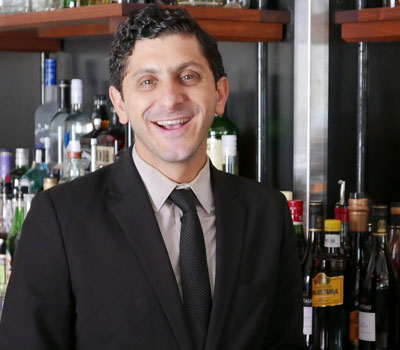Sonoma-born Noah Singerman got interested in wine while at UC Santa Cruz; he worked at Wine Cask back when Eric Railsback and Graham Tatomer were waiters, and Sideways had just come out. It wasn’t long before he moved to NYC to run some of the city’s top beverage programs, putting in time at Five Points, The Standard Hotel, as well as The Dutch and Saxon & Parole. Two years ago, after canvassing the East Coast for an affordable place to live with a great standard of living, he and his wife settled on Charleston. They’ve since bought a house, had a baby, and he’s marked his first anniversary as the head sommelier at Husk, where chef Sean Brock celebrates southern cuisine.


On a wine list arranged by soil type.
It’s one of things that makes the wine list stand out, thanks to Clint Sloan, who designed it when he was the sommelier. We get the full range of reactions: the geeky wine people who say ‘This is so cool!’—soil type has become an aspect that they are really into. But I’ve also had people say, ‘Don’t you think this is pretentious?’ And I own that. We list the wines from light to rich within the soil types, so it’s still approachable. And we do list the grape varieties, so if you prefer to choose by variety, you can go through the list that way. But we get a lot of people who are curious, and say, ‘I never thought about wine that way.’ They never thought about how wines grown in volcanic soils in Oregon, Napa and Sicily could have similarities. Or what a difference soils can make: People often point out that Oregon and Burgundy fall at the same latitudinal line, and that’s important—but soil is important too. It’s interesting to switch gears and see wine from a different perspective.
Last year when we talked, you expressed surprise at how much cabernet you sold, given Husk’s food. This year, there’s only one cabernet in the top ten—Banshee.
I upped the price on Napa cabernet to force people into Bordeaux if they want inexpensive cabernet. I wanted to give people value and quality, and in the $50 to $70 range, you’ll get better value out of Bordeaux than Napa. In Bordeaux you can find some fun artisanal Côtes de Bordeaux or Supérieur—family-made wines with a couple years of bottle age.
A Santa Barbara pinot noir, Au Bon Climat, tops your list of most popular bottles and glasses.
Pinot noir is just king; it’s unbelievable by the glass and bottle—everyone walking in the door orders it. I’ve seen it as a somm for over ten years now: Younger people and less experienced people gravitate toward pinot noir; it’s like they believe there can’t be a bad glass. I try to make sure that’s the case—our best-seller is Au Bon Climat, and by the bottle I always have four—the ABC, one from Sonoma (Ceritas), one from Oregon (Belle Pente) and then I rotate the Burgundy: The staff are comfortable with domestic pinot noir but they aren’t as familiar with Burgundy, so I rotate the wines every couple of months so we can taste and talk about Burgundies from different regions.
A Napa sauvignon blanc, from Massican, tops the list of popular white wines at Husk.
Like with pinot noir, I think it’s really important to have strong option by the glass. It’s easy to have mediocre versions of sauvignon blanc on the list because they are easy to sell, but I didn’t want to put a nondescript Sancerre on there. I’d rather force people to spend money on good ones. Yes, you can buy Sancerre for $15.99 at the store, but here, if you want it, it’s Bailly-Reverdy Sancerre and it’s $80. I wanted to have something domestic as well but with an eye toward the Old World, and I had a connection with Dan Petroski [at Massican]. His white blends get a lot of attention, but I think he also makes some of the best sauvignon blanc in the US. So, we talked and tasted a bunch of samples, deciding on one for the restaurant that’s made with a hundred percent neutral oak. Dan picks at a really tight time, so the wine has a bright crispiness up front, leading into rounder mouthfeel from the oak. When it comes to sauvignon blanc, I want people to ask, ‘Why is this more expensive,’ or to walk away thinking, ‘Wow, the Husk version really stood out for me.’ It does really well here [#2 on the best-selling bottles list)—people will buy a bottle to take away with them, too.
On zinfandel as your most successful new addition to the list
There wasn’t a zin on the list when I took over, and I’m a Sonoma County boy, so zinfandel always has a place in my heart. Zinfandel had a bad reputation for a while—big fruit, high alcohol, jam bombs. The Bedrock [Bedrock Wine Co. California Zinfandel] shows that pendulum swinging toward balance: It has a lot of fruit, but a lot of other things going on as well. I still perceive the wine-drinking community as not liking zin, so I was surprised that it was on my top ten. I’m always worried that people won’t order it because they think it’s going to be a monster wine, and I always tell the staff, make sure the guest understands it’s not 16.5 alcohol—but when they do order it, then I fear that they won’t like it because they were expecting that high-octane wine.
What’s for dinner tonight?
I’d start with wood-fired oysters: we always have them on the menu, but we rotate compound butters—right now we’re playing with one that riffs on oyster stew with bacon—with a bottle of Bernard Baudry Chinon Blanc (I took the one-case allocation for Charleston). Then I’d do the pork chop—we get in some of best pork I’ve ever had. We get in two whole hogs every Wednesday. Right now, the chops are served with a sort of hoppin’ john of Carolina Gold rice and Sea Island red peas. And I’d have the Château Musar, 2009. It’s the only wine that’s been on the list since Husk opened. We buy it by the pallet, and share it with all our restaurants. It’s on the list at $85. The staff really likes it, and people find it really fun to try Lebanese wine, and Musar in particular. It works well with the food—it’s got weight but it’s not going to hit you over the head.
is W&S’s editor at large and covers the wines of the Mediterranean and Central and Eastern Europe for the magazine.
















